Are you looking for the best saw blade to cut aluminum in 2023? You’re in luck! This guide will provide you with all the key insights to help you make an informed decision. Whether it’s for your professional projects or hobby work, finding the right saw blade is essential for your success. So don’t wait any longer and read on to learn more!
Best saw blade to cut aluminum 2023
- TOMAX TCG Aluminum Metal Saw Blade 9 (Editor’s Pick)
- Benchmark Abrasives Circular Saw Blades (Best Overall)
- Evolution Heavy Duty Chop Saw Blade (Budget Friendly)
- Diablo D1080N Non-Ferrous Metal Saw Blade
- IVY Classic 40088 Swift Cut Blade
- LAND Hacksaw Coping Saw Blade
- KATA 10 Inch Aluminum Saw Blade
1) TOMAX TCG Aluminum Metal Saw Blade

Details distinguish the TOMAX TCG Aluminium Metal Saw Blade:
Carbide Mastery: This carbide saw blade is strong and durable.
The Perfect Count: This table saw blade has 100 teeth to easily cut aluminium, plastic, and metal.
Singular Efficiency: This 14.5 x 13.2 x 0.7-inch blade weighs 2.8 pounds and arrives in one piece. Designed for efficiency.
Cut past Obstacles
Specialisation in aluminum cutting characterises the TOMAX TCG Aluminium Metal Saw Blade. This blade has the fineness for this tough material. Its carbide composition and 100 teeth let it to cut metal precisely and cleanly without harm. It can also withstand heavy use without losing its edge.
Smooth Performance, Silent Precision
The TOMAX TCG Aluminium Metal Saw Blade’s anti-vibration design advances innovation. Its reduced noise and smoother functioning make it ideal for long cutting sessions. Reduced operator weariness improves work accuracy. Its easy installation fits most conventional table saws, making it ideal for professionals and DIYers.
Your Path to Precision: Conclusion
The TOMAX TCG Aluminium Metal Saw Blade is your key to precision cutting. Its carbide construction, 100 teeth, and anti-vibration design set it apart. TOMAX makes cutting aluminium, plastic, or metal easy and precise. Improve your craftsmanship with this reliable, efficient, and durable saw blade.
Must Read – Best 7 1/4 circular saw blade
TOMAX TCG Aluminum Metal Saw Blade First Hand Review Video
Video Source: Product Buying Guide
Pros:
- Precise and clean cuts through aluminum
- Durable and long-lasting
- Anti-vibration design for smooth operation
- Easy to install and fits most standard table saws
- Perfect for professionals and DIY enthusiasts alike
Core feature
| Material | Carbide |
| Brand | TOMAX |
| Color | Silver |
| Number of Teeth | 100 |
| Style | Table Saw |
| Compatible Material | Aluminum, Plastic, Metal |
| Number of Pieces | 1 |
2) Benchmark Abrasives Circular Saw Blades
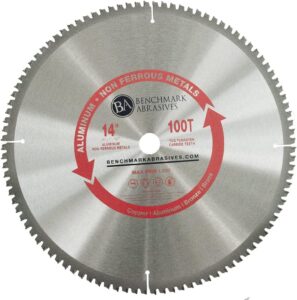
The Benchmark Abrasives Circular Saw Blade shows craftsmanship. With a steel core and tungsten carbide points, it’s strong and precise. Its durable build makes it excellent for heavy-duty operations.
Precision Sleek Design
This black circular saw blade emanates professionalism and sophistication. Whether you’re a pro or a DIYer, its style suits cutting projects.
Dimensions Matter
This saw blade is small and light at 14.25 x 14.09 x 0.59 inches and 3.59 pounds. These dimensions make handling and storage easy, decreasing fatigue during lengthy use.
Versatility at Its Best Cutting-Edge Performance
The Benchmark Abrasives Circular Saw Blade cuts through many materials with its 100 teeth and traditional shape. From fibreglass to plastic and metal, it cuts whatever you need.
Sharpness That Lasts
This saw blade stays sharp after several applications, making it unique. The steel core and tungsten carbide tips keep it efficient and deliver clean, precise cuts.
Safety First Anti-Kickback Design
Never sacrifice safety when using cutting tools. The Benchmark Abrasives Circular Saw Blade’s anti-kickback feature protects you. This feature greatly decreases accident and injury risk, making it suited for beginners and experts.
A Simple Installation
Confusion over compatibility? Fear not! This saw blade fits most circular saws, simplifying installation. It’s practical for pros and DIYers.
Conclusion
The Benchmark Abrasives Circular Saw Blade is ideal for durable, efficient, and adaptable cutting. Its high-quality materials and distinctive characteristics make it function effectively in many applications. It’s a must-have toolkit addition with safety measures for all skill levels. Precision and efficiency replace mediocre cuts with the Benchmark Abrasives Circular Saw Blade. Increase your cutting skills today!
Must Read – Best 7 inch wet tile saw blade
Benchmark Abrasives Circular Saw Blades First Hand Review Video
Video Source: 731 Woodworks
Pros:
- Made with high-quality materials for heavy use
- Suitable for cutting through various materials
- Anti-kickback design for safety
- Easy to install and fits most standard circular saws
- Versatile and useful in different applications
Core feature
| Color | Bronze |
| Number of Teeth | 100 |
| Style | Classic |
| Compatible Material | Fiberglass, Plastic, Metal |
| Number Of Pieces | 1 |
3) Evolution Heavy Duty Chop Saw Blade
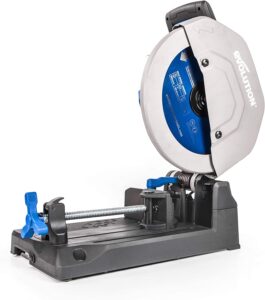
A wonderful blend of alloy, metal, stainless steel, and steel elements makes the Evolution Heavy Duty Chop Saw Blade strong. Its sleek black finish gives it a professional look and modernises cutting duties. This heavyweight champion is built for severe cutting duties, giving it a reliable companion for tough materials.
Best Versatility
Versatility defines the Evolution Heavy Duty Chop Saw Blade. This multicoloured masterpiece handles wood and metal surfaces well. It cuts a variety of materials because to its alloy and metal composition. This 120-volt blade is 20.8″L x 16.2″W x 12.2″H and powered by corded electricity, ensuring its readiness.
Combined Precision and Efficiency
This saw blade excels in cutting through various materials quickly. The alloy, metal, stainless steel, and steel protect it from wear and tear, preserving sharpness and efficiency. Its large cutting capacity makes it perfect for effortlessly slicing heavy materials.
Unmatched Flexibility
The Evolution Heavy Duty Chop Saw Blade revolutionises cutting tool flexibility. It excels beyond wood and metal, making it useful in many fields. Corded electricity keeps this blade ready without battery replacements or recharging.
Finally
The Evolution Heavy Duty Chop Saw Blade is a powerful, versatile, and reliable cutting instrument. For precise and efficient cutting, its technical qualities set it apart from its competitors. Upgrade your cutting experience with this amazing saw blade and experience maximum performance and precision.
Must Read – Best 8 1/4 table saw blade
Evolution Heavy Duty Chop Saw Blade First Hand Review Video
Video Source: Making Stuff
Pros:
- Durable and resistant to wear and tear
- Can cut through different materials quickly and efficiently
- Large cutting capacity
- Versatile and suitable for cutting wood, metal, and other materials
- Corded electricity ensures it is always ready for use
Core feature
| Brand | Evolution |
| Color | Multicolor |
| Surface Recommendation | Wood, Metal |
| Power Source | Corded Electric |
4) Diablo D1080N Non-Ferrous Metal Saw Blade
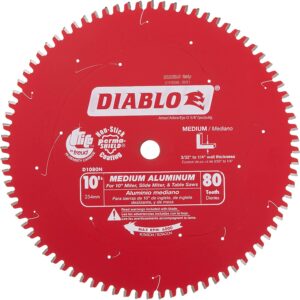
The Diablo D1080N’s sleek, modern look matches its high-quality workmanship. Its compact and ergonomic design makes it easy to handle and store for experts and DIYers. This silver-finished saw blade operates well and looks great.
Lightweight, agile
When using tools for long periods, weight matters. The D1080N’s lightweight design reduces strain during long cutting sessions, ensuring precision and control. This blade is easy to use, so say goodbye to bulky equipment.
Flexible Non-Ferrous Metal Cutting
The Diablo D1080N excels in cutting non-ferrous metals. Aluminium, copper, and brass are all covered by this blade. Carbide structure keeps it sharp and durable after several applications. Its 80 round teeth make clean, precise cuts.
Reduced Noise and Precision
Laser-cut stabiliser vents reduce D1080N noise and vibration. This improves workplace comfort and lowers operator fatigue. Without noise and vibration, you can concentrate.
Easy Installation
Installing the Diablo D1080N is easy with most circular saws. Professionals or DIYers won’t have trouble setting up. Making your job easier is key.
Conclusion
Overall, the Diablo D1080N Non-Ferrous Metal Saw Blade is a circular saw blade standout. Its carbide construction, 80 teeth, and compatibility with non-ferrous metals make it a top choice for precision and efficiency. The lightweight design, decreased noise, and quick installation make it a must-have for metalworkers.
Use the Diablo D1080N to improve your metalworking game instead of using inferior cutting tools. Try quality and see the difference.
Must Read – Best 10 inch table saw blade
Diablo D1080N Non-Ferrous Metal Saw Blade First Hand Review Video
Video Source: Shop Tool Reviews
Pros:
- Makes clean and precise cuts through different non-ferrous metals
- Designed with laser-cut stabilizer vents that reduce noise and vibration
- Compatible with various non-ferrous metals
- Easy to install and fits most standard circular saws
- Suitable for professionals and DIY enthusiasts
Core feature
| Product Dimensions | 0.2 x 12 x 14 inches |
| Item model number | D1080N |
| Is Discontinued By Manufacturer | No |
| Size | Pack of 1 |
| Color | Multi |
| Style | Circular |
5) IVY Classic 40088 Swift Cut Blade

IVY Classic makes high-quality gear, including the 40088 Swift Cut Blade. This alloy steel, iron, and metal saw blade is sturdy. Its durability lets you utilise it for many tasks.
Fast and Accurate Cutting
IVY Classic 40088 rapid Cut Blades are known for their rapid cuts. This design cuts quickly, cleanly, accurately. As a professional or DIYer, this blade’s finely ground teeth will reduce finishing and sanding time.
Flexibility in Cutting
This saw blade cuts well in many materials. It slices aluminium, alloy steel, iron, and other metals easily. Its adaptability removes the need for many blades, making it excellent for material applications.
User-Friendly Design
The IVY Classic 40088 Swift Cut Blade prioritises comfort. Weighty construction lessens fatigue after extended use and makes it easy to handle and store. Easy cutting is the goal of this blade.
Simple Install
IVY Classic 40088 Swift Cut Blade setup is easy. It fits most circular saws, making it suitable for professionals and DIYers. No compatibility issues or complicated setups—just attach the blade and cut.
A Professional Look
This saw blade looks good and works well. Silver provides your tools a professional look. Reliable, stylish workplace equipment makes all the difference.
The IVY Classic 40088 Swift Cut Blade is a tough, accurate, and adaptable saw blade. Its solid construction, rapid cutting, and user-friendly design make it a reliable cutting tool. Upgrade your cutting efficiency and simplify projects with this IVY Classic saw blade.
Must Read – Best 12 inch miter saw blade
IVY Classic 40088 Swift Cut BladeFirst Hand Review Video
Video Source: MakitaCorporation
Pros:
- Resistant to wear and tear, ensuring that it remains sharp and efficient
- Precision ground teeth design ensures clean and accurate cuts
- Compatible with various materials
- Easy to install and fits most standard circular saws
- Suitable for professionals and DIY enthusiasts
Core feature
| Material | Alloy Steel, Iron, Metal |
| Brand | IVY Classic |
| Item Dimensions LxWxH | 10 x 10 x 0.09 inches |
| Color | Black |
| Style | 1-Pack |
| Item Weight | 0.26 Pounds |
6) LAND Hacksaw Coping Saw Blade

The LAND Hacksaw Coping Saw Blade is precision-made from carbon steel for unparalleled durability. Orange and black exterior offers visual appeal and woodwork compatibility. The blade’s 15.5″L x 6.5″W x 5.5″H proportions make it versatile.
Easy Wood Cutting
This blade slices wood easily, which is a notable feature. Its carbon steel construction resists wear and tear, keeping it sharp and efficient after numerous uses. Precision honed teeth ensure clean, precise cuts, eliminating post-cut finishing and sanding.
Woodworking Versatility
The flexible LAND Hacksaw Coping Saw Blade can easily cut various wood types. This versatility makes it a popular saw blade. This blade’s design makes it easy for pros and DIYers.
Conclusion
The LAND Hacksaw Coping Saw Blade cuts wood materials well and is durable, efficient, and adaptable. Its remarkable technological features and user-friendly design make it the best choice for all woodworking jobs. Upgrade your woodworking game with this LAND saw blade.
Must Read – Best 12 sliding compound miter saw blade
LAND Hacksaw Coping Saw Blade First Hand Review Video
Video Source: Catus Maximus
Pros:
- Durable and resistant to wear and tear
- Precision ground teeth design ensures clean and accurate cuts
- Versatile and suitable for cutting different wood materials
- Easy to use and handle
- Suitable for both professionals and DIY enthusiasts
Core feature
| Brand | LAND |
| Color | Orange, Black |
| Blade Material | Carbon Steel |
| Surface Recommendation | Wood |
| Product Dimensions | 15.5″L x 6.5″W x 5.5″H |
7) KATA 10 Inch Aluminum Saw Blade
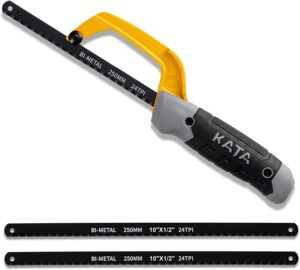
The KATA 10 Inch Aluminium Saw Blade is unique. It excels in quality, durability, and adaptability. What makes this saw blade great?
Advanced Construction
This saw blade has a sturdy aluminium frame and flexible bi-metal HSS blades. This mix makes every cut durable and precise. The orange, black, and grey colour palette adds refinement, while the surface recommended for indoor and outdoor use makes it versatile for cutting.
Dimensions and Power
This saw blade balances compactness and efficiency at 11.4″L x 2.75″W x 1.18″H. Its 3.4 amps make it a useful tool for even the toughest cutting chores.
Unleash Versatility
Its adaptability makes the KATA 10 Inch Aluminium Saw Blade stand out. This blade cuts wood, plastic, and metal easily. This makes it excellent for indoor and outdoor DIY and craftsman projects.
Advantage of Cutting Edge
The aluminum frame and bi-metal HSS blades keep this saw blade sharp. Its wear-resistant design eliminates blade changes, providing consistent performance after several usage. For varied cutting applications, its DIY and craftsman-specific features make it the best choice.
Conclusion
The KATA 10 Inch Aluminium Saw Blade revolutionises material cutting. It stands out due to its creative design, durability, and versatility. This saw blade will exceed your expectations whether you’re a skilled carpenter or a DIYer. Try the KATA 10 Inch Aluminium Saw Blade today and see the difference.
Must Read – Best band saw blade
KATA 10 Inch Aluminum Saw Blade First Hand Review Video
Video Source: Catus Maximus
Pros:
- Flexible and able to cut through different materials
- Durable and resistant to wear and tear
- Special feature for DIY and craftsmen use
- Versatile and suitable for both indoor and outdoor use
- Can handle heavy-duty cutting tasks with an amperage of 3.4 amps
Core feature
| duct Dimensions | 11.4″L x 2.75″W x 1.18″H |
| Amperage | 3.4 Amps |
| Number of Teeth | 2 |
| Number of Batteries | Unknown batteries required. |
| Manufacturer | KATA TOOLS |
Best saw blade to cut aluminum 2023-Complete buying Guide
When it comes to completing a project that involves cutting aluminum 2023, having the right saw blade is essential. Whether you are a novice craftsman or a professional contractor, it is important to have the necessary knowledge of how to select the best saw blade for the job.
This comprehensive guide will provide an overview of different types of saw blades available and how they can best be used on aluminum 2023. It will also offer exemplary tips and tricks which should help you make informed purchasing decisions. By understanding this guide thoroughly, you will be able to navigate between various blades more easily and make more precise cuts on your aluminum 2023 projects.
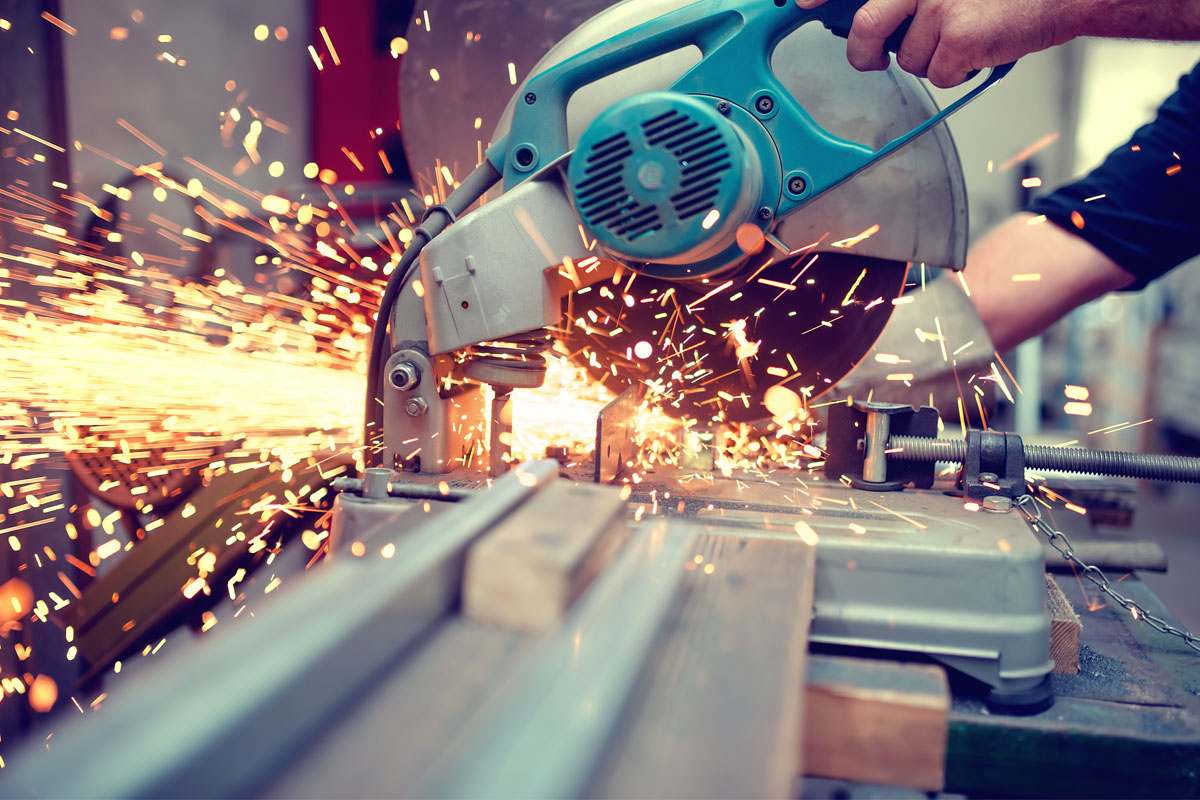
Photo Source: bobvila.com
Explanation of the importance of choosing the right saw blade to cut aluminum
When it comes to cutting aluminum, the saw blade you choose is very important. The type of saw blade used can have a major impact on the quality of the finished product, so it is essential to select the saw blade that best suits your needs. There are several factors to consider when choosing the correct saw blade for a given job, including:
- Blade diameter – larger blades can more effectively dissipate heat buildup, which will help prevent damage to the material being cut.
- Size of teeth and number of teeth – smaller TPI (teeth per inch) and PPI (points per inch) ratings will provide smoother cuts while larger ratings will give you faster cutting speeds but rougher edges.
- Hook angle – increasing hook angle can help reduce tedious secondary finishing work by providing cleaner edges with improved chip clearing power.
It’s important to select the correct combination of everything mentioned above in order to get an efficient working environment with good results for your specific application. Taking a few moments up front to carefully consider all these factors before selecting a saw blade will save significant time and effort further down the line; it may even save you from costly mistakes or damages!
Overview of the key factors to consider when buying a saw blade
When selecting a saw blade to cut aluminum, there are a few key factors to bear in mind. This includes blade type and diameter, tooth pattern, plate thickness, material and kerf. In addition, the type of aluminum you’re working with is also important. Here’s an overview of the key factors to consider when buying a saw blade for aluminum applications:
- Blade type: Circular saws use either thin-kerf or full-kerf blades. Thin-kerf blades have thinner plates and require less power to operate than full-kerf blades and are better for small projects and lighter materials; however their cutting capacity is usually lower than their full-kerf counterparts. The full-kerf option provides greater precision cuts at higher speeds but is best used on heavier materials due to its higher power requirement.
- Diameter: The size of the saw blade typically ranges from 4 1/4 inches up to as large as 12 inches or more depending on your specific application needs. For cutting aluminum sheets thinner than ⅛ inch thick, a smaller diameter should suffice while thicker pieces of metal will require larger diameter possibilities such as 10” or 12” blades.
- Tooth pattern: Usually designated by the number #T (teeth); the more teeth on a saw blade the smoother it will cut but at the expense of less aggressive feed rates which can lead to increased heat buildup during cuts (#T =14 – 24T). A general purpose aluminum blade has between 40 – 80T, while trimming & finish work requires teeth counts as high as 200+.
- Plate thickness: Thickness of plate relates to how rigid/stable/durable your sawblade is – thin blades (0 .025 in.) are good for light duty applications where plastic & wood need quick cuts but can work efficiently with almost any lightweight material; thick plates (0 .062 in.) are designed for long term heavy duty use with harder metals like stainless steel & aluminium alloys (13% greater rigidity vs 0 .025in.).
- Material: Aluminum is softer than most other metals so it requires a different grade carbide material on its gutters/router teeth compared with steel blades – these are usually carbide tipped which resists shock & heat much better enabling longer life span on cuts while still keeping sharpness & providing clean accurate finishing results across most types of surfaces from woodworking through construction projects & manufacturing settings alike.
- Kerf width: Kerfs refer to gaps between each tooth which allow for material removal during cutting process – tight kerfs (~1/8”) provide clean precise finish often favored in furniture making whereas wider kerfs (~3/16”+ up) make speedier cuts ideal for industrial / construction tasks which have not need aim towards aesthetics because welded edges make them unsuitable anyway so it will be left visible.
Blade Material
The material of the blade is an important consideration when purchasing a saw blade for cutting aluminum. There are several types of materials used for making saw blades, including steel, tungsten carbide-tipped (TCT), diamond, and titanium-coated blades.
Steel blades are the most common type of saw blade and can be divided into two sub types: high speed steel (HSS) and alloy steel. HSS blades are made from hardened stainless steel and are suitable for cutting metal materials such as aluminum due to their very sharp edges. Alloy steel is another material used in saw blades that tends to be more durable than HSS but requires more frequent sharpening due to dulling more quickly.
TCT blades are made with a hard material such as tungsten carbide embedded in softer metal, allowing them to resist wear better than regular HSS blades. They also have a longer useful life than other blade types making them suitable for extended use with aluminum or other metals that need a consistent cutting type.
Diamond saw blades contain tiny diamonds embedded in the edge of the blade, allowing them to cut through particularly hard materials such as granite or some metals like aluminum alloy with ease. Although they may cost a bit more than other types of blades due to the diamonds being used, they are well worth the extra expense because they seldom need sharpening and can last for many years if taken care of properly.
Finally, titanium-coated saw blades combine both hardness and heat-resistance into one product by coating a regular steel or TCT saw blade with titanium nitride in order to increase its durability while protecting it from heat buildup during cuts on various materials such as aluminum alloys.
Explanation of the different materials used in saw blades
When it comes to cutting aluminum with a saw blade, choosing the right material for your application is key. There are a variety of materials available for saw blades, and each material has certain attributes that make it unique and enhance its performance or application. The most common materials used in saw blades are high-speed steel (HSS), tungsten carbide-tipped (TCT), and diamond-tipped (diamond).
- High-speed steel (HSS): This is the most common material used in saw blades. It is often referred to as plain steel since it does not contain any added alloying elements such as tungsten, cobalt or vanadium. This type of saw blade will usually run at higher speeds than other materials and offers good resistance to wear.
- Tungsten Carbide-Tipped (TCT): TCT blades are manufactured by combining a solid tungsten carbide tip with a body made of an alloyed medium carbon steel known as M2 tool steel or better known as High Speed Steel (HSS). The combination creates an incredibly hard saw blade that offers superior heat resistance, making them ideal for harder metals such as titanium, aluminum, stainless steel and even concrete.
- Diamond: Diamond tipped blades are the ultimate choice for cutting aluminum because of their ability to cut much harder materials than HSS or TCT blades without wearing out quickly or losing their edge over time. They are manufactured by brazing diamond grains onto prongs that have been welded to a variety of substrates such as carbon steel plates for use in band saws. Offering superior performance compared to both HSS and TCT blades, diamond tipped blades provide quick clean cuts with minimal heat build up when cutting through aluminum.
Discussion of the advantages and disadvantages of each material
When it comes to saw blades, their material characteristics largely determine the type of cut they produce. A harder saw blade can provide longer lasting and more precise cuts, while a softer saw blade may be more suitable for rougher jobs. Depending on the application, there are a variety of materials that provide different strengths and capabilities when it comes to saw blades.
- Carbide: Carbide saw blades contain hard, dense materials that are often combined with cobalt or tungsten. These are extremely resistant to heat and wear, making them perfect for cutting tough metals like aluminum. They also offer excellent accuracy and control over delicate projects such as producing intricate shapes and grooves. On the other hand, carbide-tipped blades are very costly compared to other types, so you may not always get the best value for your money depending on what you’re cutting.
- HSS (High Speed Steel): High Speed Steel (HSS) saw blades contain a combination of chromium, molybdenum and tungsten which make them suitable for use under high temperatures generated during cutting operations. Furthermore, steel is significantly easier on your wallet than carbide-tipped blades. However, HSS saws offer little resistance against softer metals like aluminum due to their low hardness when compared to carbide tips; this means that they won’t last as long if used extensively on these types of materials or generate as precise or clean of a cut due to their shortened life span when cutting aluminum 2023 alloys in particular.
- Titanium: Titanium-coated blades are made up of titanium nitride which gives them increased durability and strength over standard steel teeth due to its chemical properties being closer aligned with those used in diamond cutting tools than just steel alone – making them ideal even for harder metals like aluminium 2023 alloys which require precision cuts with minimal friction caused by extra heat build up during operation. While more expensive than HSS blades – titanium coated models still dwindle in comparison when it comes to pricing with those sporting Carbide reinforcements; additionally these do wear out faster than either HSS or Carbide reinforced teeth but may result in cost savings in overall tool maintenance costs if not going after extreme precision finer finishes associated with Carbide tipped saw blade teeth designs.
III. Blade Teeth
The number of teeth on a saw blade is one factor that determines the type of cut it produces. Blades with fewer teeth move or “clear” more material as they pass through, while blades with more teeth produce finer cuts. Generally speaking, Aluminum 2023 is best cut with a saw blade that has 18 or fewer teeth per inch (TPI). At this tooth count the blade can achieve decent cutting speed and still provide an acceptable surface finish.
Tooth shape is another important factor to consider when selecting a saw blade for cutting aluminum. Hook-angle blades are frequently used to cut thin materials such as aluminum because they do not get clogged up with chips and resin as easily. The other common tooth shape for saw blades is the alternate top bevel (ATB). ATB blades make cleaner cuts than hook-angle blades because the alternating top bevels shear material away from the cut line, producing less friction and heat buildup in the kerf.
Explanation of the different types of blade teeth
The different types of blade teeth have been developed for cutting various materials, from metal to non-metal. For aluminum fabrication, one of the most essential factors to consider is the configuration and number of blades teeth that allow for smooth cuts without compromising the quality and integrity of the material.
When selecting a blade, look out for either FTG (flat top grind) or ATB (alternate top bevel) configurations. For both types, each tooth has two sharp cutting edges that intersect with an angle between them. The primary difference between these configurations lies in the beveled angle at the tip, which increases cutting speed and minimizes material loss during different operations on aluminum such as ripping or crosscutting.
FTG blades consist of flat top teeth shaped like a trapezoid and generally feature four cutting edges per tooth separated by alternating flat sides and a negative rake angle that results in faster, cleaner cuts. Combined with larger gullets between each tooth, this reduces chip buildup and helps evacuate materials offsite better than ATB blades during ripping operations.
ATB blades have alternating top bevels (ATBs) in their design which have alternating right-handed and left-handed positions in each row of teeth that create tiny chisels with each pass through aluminum leaving smooth finishes in crosscutting applications such as trimming sheet metal parts or cutting edge slots on aluminum extrusions. The side grinds provide additional support to handle tough materials while offering less clearance than its FTG counterpart resulting in slower rip speeds but more thorough crosscut results.
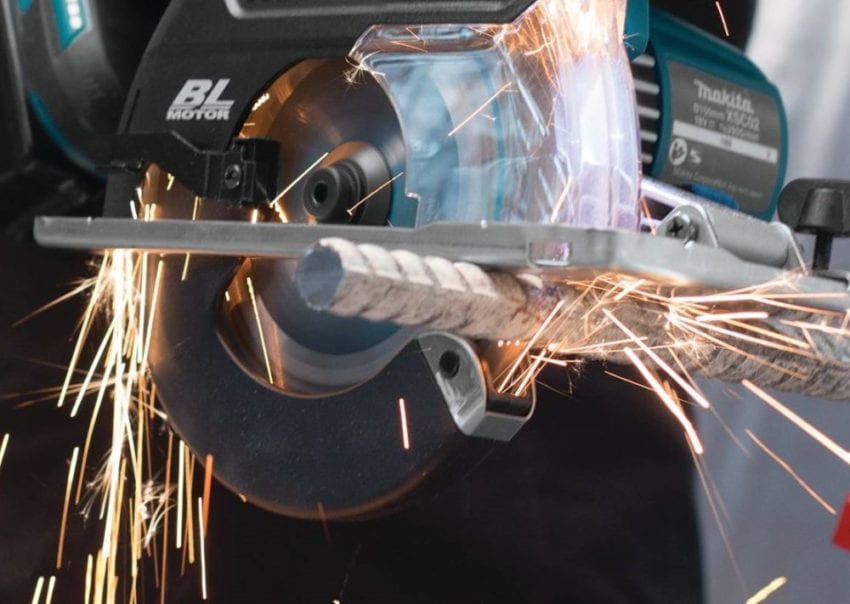
Photo Source: protoolreviews.com
Discussion of the advantages and disadvantages of each type
Each type of saw blade offers different advantages and disadvantages when it comes to cutting aluminum. It is important to understand the difference between the blades before selecting one for your project.
- Circular Saw Blades: These are the most common blades used in woodworking, and they can also be used to cut aluminum with efficiency. However, their teeth cannot handle extremely thick or hard materials, and they will require frequent sharpening due to their high tooth density. They are also limited in size range, so you may need multiple sizes for a large project.
- Table Saw Blades: Table saw blades offer a wider range of sizes than circular saw blades, so these pieces of equipment can handle larger pieces of aluminum material more easily than smaller ones. They are durable and provide a good balance between speed and control, though you’ll need to choose the right type for your specific project. Choose one with 56 – 80 teeth for maximum performance when cutting aluminum.
- Tungsten-Carbide-Tipped (TCT) Saw Blades: TCT saw blades use tipped carbide which provides them with excellent performance when cutting aluminum along with long life span due to minimized friction between blade teeth while cutting. The disadvantage is they are usually expensive compared to other saw types and require greater attention during use such as cooling lubricant or dust collection device due to their fast spins which helps prevent them from getting heat up quickly during operation leading potential failure or even damage nearby metal parts due its potential sparks during cuts. Other than that TCT saws have no major drawbacks if handled properly in right environment making them ideal choice in certain metal working projects like very thick metals which needs slow but accurate cuts resulting best possible quality finish work at end of project time frame.
Conclusion
In conclusion, the best saw blade to cut aluminum 2023 will depend on your intended application and the type of cutting job you need to accomplish. When choosing a saw blade for aluminum, pay attention to its materials, design features, and the kind of cut that it is intended for. Keep in mind that most blades are designed to make either straight or smooth cuts so if you require a more detailed cut then you may need to opt for a specialized blade.
Finally, select a saw blade size and RPM according to the thickness of your aluminum material as well as your own particular work setup or preferences. By following these guidelines, you’re sure to find an ideal saw blade for any aluminum cutting job that might come your way.
FAQ’S
What is best for cutting aluminium?
For cutting aluminum, specialized saw blades, such as metal cutting blades or hacksaw blades designed for aluminum, are the best choice.
What band saw blade to cut aluminum?
A specialized band saw blade designed for cutting aluminum is recommended.
Do you need a special saw to cut aluminum?
Yes, it is recommended to use a specialized saw with a blade designed for cutting aluminum, rather than a wood saw blade.
What is the best saw blade for cutting aluminum extrusion?
The best saw blade for cutting aluminum extrusion will depend on the thickness of the material, but a blade with a lower TPI and carbide-tipped teeth is often recommended.
What is the best TPI for cutting aluminum?
he best TPI for cutting aluminum will vary depending on the thickness of the material, but a lower TPI, such as 18, is often recommended for cutting thicker aluminum.
What is the fastest way to cut aluminum?
A power saw or chop saw with a specialized blade for cutting aluminum is the fastest way to cut the material.
Can a wood saw blade cut aluminum?
No, a wood saw blade is not recommended for cutting aluminum as it is not designed for metal cutting and may not produce clean cuts or last as long as a specialized blade.
What is the best hacksaw blade for Aluminium?
A hacksaw blade designed specifically for cutting aluminum is the best choice.
Is Aluminium hard to cut?
Aluminum is a relatively soft metal and can be cut relatively easily with the right tools and techniques.
What speed should you cut aluminum?
The speed at which you cut aluminum will depend on the thickness of the material and the saw being used, but typically ranges from 80 to 120 feet per minute.

Michael Lilli is the author and CEO of sawbladetown.com and Informative Website. With over 10 years of experience in the saw blade industry, Michael has become a leading expert in the field. He is dedicated to helping professionals and hobbyists alike find the perfect saw blade for their projects. Through his informative website and writing, Michael shares his knowledge and expertise on everything from saw blade anatomy to advanced techniques and safety precautions. His passion for saw blades and commitment to helping others has made him a trusted resource in the industry.

